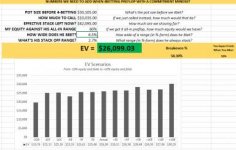tewwa94
Enthusiast
Silver Level
But if villain has KJ AJ I'm loosing too. If it's weird if (s)he does that with a T. There are a few pocket 44,55 that make a similar line. Also I cannot think of that many hands that make sense to bluff with there. Only win against overplayed J9, J8, a rare 67 or T. BUT... since I only had 2 hands from villain, the hands after s(he) started to play a very loose agressive-ish style, so there's a chance that I got bluffed here against a random hand, villain thinking that I was c betting with nothing (which I was on the flop). Any thoughts?
pokerstars - 600/1200 Ante 90 NL - Holdem - 9 players
Hand converted by Holdem Manager 3
UTG: 30,082 (25.1 bb)
UTG+1: 35,640 (29.7 bb)
MP: 42,151 (35.1 bb)
MP+1: 25,401 (21.2 bb)
Hero (MP+2): 163,212 (136 bb)
CO: 17,555 (14.6 bb)
BTN: 29,627 (24.7 bb)
SB: 80,745 (67.3 bb)
BB: 61,550 (51.3 bb)
9 players post ante of 90, SB posts 600, BB posts 1,200
Pre Flop: (pot: 2,610) Hero has

4 folds, Hero raises to 2,400, 3 folds, BB calls 1,200
Flop: (6,210, 2 players)


BB checks, Hero bets 1,863, BB calls 1,863
Turn: (9,936, 2 players)
BB checks, Hero bets 5,067, BB raises to 15,102, Hero calls 10,035
River: (40,140, 2 players)
BB bets 42,095 and is all-in, Hero folds
Results: 40,140 pot (0 rake)
Final Board:




BB wins 40,140
pokerstars - 600/1200 Ante 90 NL - Holdem - 9 players
Hand converted by Holdem Manager 3
UTG: 30,082 (25.1 bb)
UTG+1: 35,640 (29.7 bb)
MP: 42,151 (35.1 bb)
MP+1: 25,401 (21.2 bb)
Hero (MP+2): 163,212 (136 bb)
CO: 17,555 (14.6 bb)
BTN: 29,627 (24.7 bb)
SB: 80,745 (67.3 bb)
BB: 61,550 (51.3 bb)
9 players post ante of 90, SB posts 600, BB posts 1,200
Pre Flop: (pot: 2,610) Hero has
4 folds, Hero raises to 2,400, 3 folds, BB calls 1,200
Flop: (6,210, 2 players)
BB checks, Hero bets 1,863, BB calls 1,863
Turn: (9,936, 2 players)
BB checks, Hero bets 5,067, BB raises to 15,102, Hero calls 10,035
River: (40,140, 2 players)
BB bets 42,095 and is all-in, Hero folds
Results: 40,140 pot (0 rake)
Final Board:
BB wins 40,140


